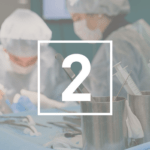Are you looking for a gynecomastia treatment specialist in Barcelona?
In men, the breast areas can become abnormally developed due to hormonal changes and imbalances among other causes, leading to an enlarged chest and possible consequent self-image problems.
Depending on the causes of this hypertrophy (hormonal imbalance or excess fat), different surgical treatments can be performed to restore a harmonious shape to the chest so that the patient can regain full confidence.
If you are interested in this type of cosmetic surgery, do not hesitate to make an appointment now with one of our cosmetic surgeons so that they can propose a treatment plan adapted to your situation.
Treatment info
| Surgery duration | 1h |
|---|---|
| Recovery | 1 week |
| Results | Long-lasting |
| Effects | Immediate |
| Hospitalization | Not necessary |
| Anesthesia | Local with sedation or general |
Speed up your treatment!
To make an appointment or speak with one of our team members, please contact us using the options below.

What is gynecomastia?
Gynecomastia is the term used to describe the excessive development of the male mammary gland resulting in a prominent breast, which is more commonly associated with the female gender. Gynecomastia can affect one or both breasts, more or less symmetrically and at different ages.
When the hypertrophy of the breast is linked to a localised excess of fat, it is called adipomastia. However, most often the two phenomena go hand-in-hand in which case we name it adipo-gynecomastia.
What causes gynecomastia in men?
Gynecomastia is very common, and is most often related to an imbalance of the hormones estrogen and testosterone.
Gynecomastia can also be a symptom of a disease such as :
- Tumours of the testicle, adrenal gland, pituitary gland, or lung
- Klinefelter's syndrome, where a man has one, two or three extra chromosomes
- Kidney disease, thyroid disease, cirrhosis of the liver
- Testicular hormonal insufficiency
Finally, certain drugs can also cause excessive development of the mammary glands: oestrogens, cimetidine and spironolactone, in particular.
In many cases, however, no cause is found. This is called idiopathic gynecomastia.
What is the treatment for gynecomastia?
If gynecomastia is related to an identified cause, the treatment will address the cause of the gynecomastia:
- Treatment of the disease causing the gynecomastia
- Replacement of the drug when it is related to side effects
- Hormonal treatment in case of hormonal imbalance
If no cause is found for gynecomastia or if medical treatment fails in cases where a cause exists, the only way to treat gynecomastia is to remove the excess tissue.
Most of the time, the operation combines liposuction of the excess fat cells and removal of the mammary gland.
Who should undergo male breast surgery?
Often benign and very common, male breast enlargement is often a source of self-image and confidence problems, because it obviously alters the appearance of the male body. The physical discomfort, which can sometimes go as far as pain, goes hand in hand with significant psychological discomfort, particularly during adolescence.
The treatment of gynecomastia is therefore aimed in particular at men who have disabling worries and self-consciousness about the feminine aspect of their breasts, suffering psychologically and sometimes physically.
Often fearing getting help for this condition, the many affected men should know that there is nothing to be ashamed or worried about, a professional medical team treats you in an informative, friendly and confidential manner.
Revamp Your Body!
Do not hesitate to make an appointment with one of our gynecomastia treatment specialists for a personalised assessment.

Gynecomastia: your treatment at Turó Park Aesthetic Clinic

Step 1 : Preliminary consultation
During the first consultation in our cosmetic surgery department, the surgeon will carry out an interview and clinical examination to find out when the phenomenon appeared, whether it is unilateral or bilateral, whether the breast is dense or soft (glandular or fatty), whether it is accompanied by ptosis (drooping with excess skin), and to define the origin of the gynaecomastia.
A hormonal assessment as well as additional examinations may also be required, depending on the individual case. The aim of this initial consultation is to establish a diagnosis in order to draw up a suitable treatment plan.

Step 2: Surgery
The surgery itself lasts between 1 and 2 hours and usually requires a 24-hour hospital stay. It is performed under general anaesthesia and usually begins with liposuction to treat the fatty part of the gynecomastia.
In a second step, the mammary gland is removed through an incision and, in case of excess skin, part of the skin is removed, leaving a scar either circular around the areola or horizontal and/or vertical to the breast.

Step 3: Postoperative
At the end of the operation, a drain is placed in order to evacuate the blood and lymphatic residues that may accumulate on the surgical site.
The pain is generally mild and is well controlled by classic analgesics. However, a feeling of tension may be felt for a few days. Bruising and swelling may also occur immediately after the operation.
The recovery time is 1 to 3 weeks. The continuation of physical activities occurs after 1 month. Your surgeon will give you instructions concerning the carrying of loads and swimming, in particular.
Our gynecomastia treatment specialists

Our answers to the most frequently asked questions about the treatment of gynecomastia
Gynecomastia: can weight training help?
Is gynecomastia serious?
What are the possible complications of gynecomastia treatment?
Aesthetic companies and organisations













